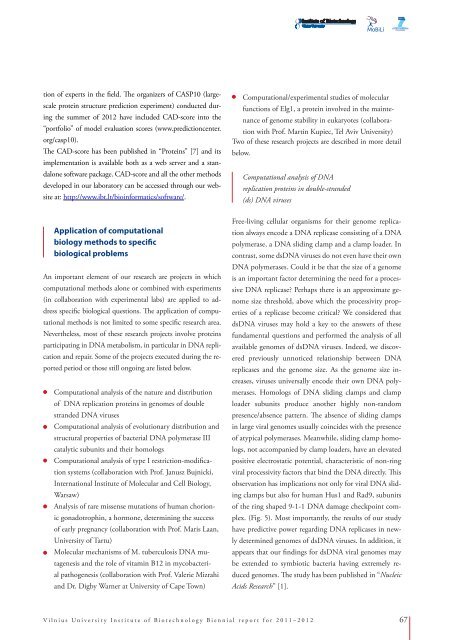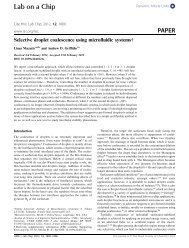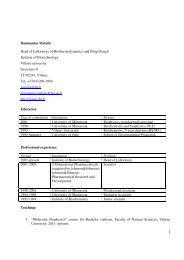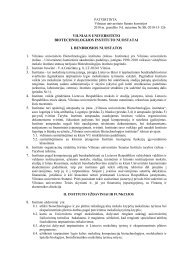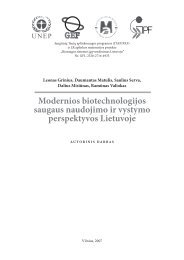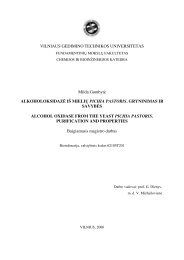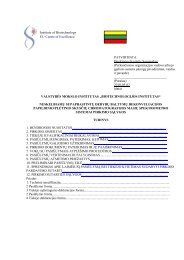Biennial Report 2011â2012
Biennial Report 2011â2012
Biennial Report 2011â2012
You also want an ePaper? Increase the reach of your titles
YUMPU automatically turns print PDFs into web optimized ePapers that Google loves.
tion of experts in the field. The organizers of CASP10 (largescale<br />
protein structure prediction experiment) conducted during<br />
the summer of 2012 have included CAD-score into the<br />
“portfolio” of model evaluation scores (www.predictioncenter.<br />
org/casp10).<br />
The CAD-score has been published in “Proteins” [7] and its<br />
implementation is available both as a web server and a standalone<br />
software package. CAD-score and all the other methods<br />
developed in our laboratory can be accessed through our website<br />
at: http://www.ibt.lt/bioinformatics/software/.<br />
Computational/experimental studies of molecular<br />
functions of Elg1, a protein involved in the maintenance<br />
of genome stability in eukaryotes (collaboration<br />
with Prof. Martin Kupiec, Tel Aviv University)<br />
Two of these research projects are described in more detail<br />
below.<br />
Computational analysis of DNA<br />
replication proteins in double-stranded<br />
(ds) DNA viruses<br />
Application of computational<br />
biology methods to specific<br />
biological problems<br />
An important element of our research are projects in which<br />
computational methods alone or combined with experiments<br />
(in collaboration with experimental labs) are applied to address<br />
specific biological questions. The application of computational<br />
methods is not limited to some specific research area.<br />
Nevertheless, most of these research projects involve proteins<br />
participating in DNA metabolism, in particular in DNA replication<br />
and repair. Some of the projects executed during the reported<br />
period or those still ongoing are listed below.<br />
Computational analysis of the nature and distribution<br />
of DNA replication proteins in genomes of double<br />
stranded DNA viruses<br />
Computational analysis of evolutionary distribution and<br />
structural properties of bacterial DNA polymerase III<br />
catalytic subunits and their homologs<br />
Computational analysis of type I restriction-modification<br />
systems (collaboration with Prof. Janusz Bujnicki,<br />
International Institute of Molecular and Cell Biology,<br />
Warsaw)<br />
Analysis of rare missense mutations of human chorionic<br />
gonadotrophin, a hormone, determining the success<br />
of early pregnancy (collaboration with Prof. Maris Laan,<br />
University of Tartu)<br />
Molecular mechanisms of M. tuberculosis DNA mutagenesis<br />
and the role of vitamin B12 in mycobacterial<br />
pathogenesis (collaboration with Prof. Valerie Mizrahi<br />
and Dr. Digby Warner at University of Cape Town)<br />
Free-living cellular organisms for their genome replication<br />
always encode a DNA replicase consisting of a DNA<br />
polymerase, a DNA sliding clamp and a clamp loader. In<br />
contrast, some dsDNA viruses do not even have their own<br />
DNA polymerases. Could it be that the size of a genome<br />
is an important factor determining the need for a processive<br />
DNA replicase Perhaps there is an approximate genome<br />
size threshold, above which the processivity properties<br />
of a replicase become critical We considered that<br />
dsDNA viruses may hold a key to the answers of these<br />
fundamental questions and performed the analysis of all<br />
available genomes of dsDNA viruses. Indeed, we discovered<br />
previously unnoticed relationship between DNA<br />
replicases and the genome size. As the genome size increases,<br />
viruses universally encode their own DNA polymerases.<br />
Homologs of DNA sliding clamps and clamp<br />
loader subunits produce another highly non-random<br />
presence/absence pattern. The absence of sliding clamps<br />
in large viral genomes usually coincides with the presence<br />
of atypical polymerases. Meanwhile, sliding clamp homologs,<br />
not accompanied by clamp loaders, have an elevated<br />
positive electrostatic potential, characteristic of non-ring<br />
viral processivity factors that bind the DNA directly. This<br />
observation has implications not only for viral DNA sliding<br />
clamps but also for human Hus1 and Rad9, subunits<br />
of the ring shaped 9-1-1 DNA damage checkpoint complex.<br />
(Fig. 5). Most importantly, the results of our study<br />
have predictive power regarding DNA replicases in newly<br />
determined genomes of dsDNA viruses. In addition, it<br />
appears that our findings for dsDNA viral genomes may<br />
be extended to symbiotic bacteria having extremely reduced<br />
genomes. The study has been published in “Nucleic<br />
Acids Research” [1].<br />
Vilnius University Institute of Biotechnology <strong>Biennial</strong> report for 2011–2012 67


